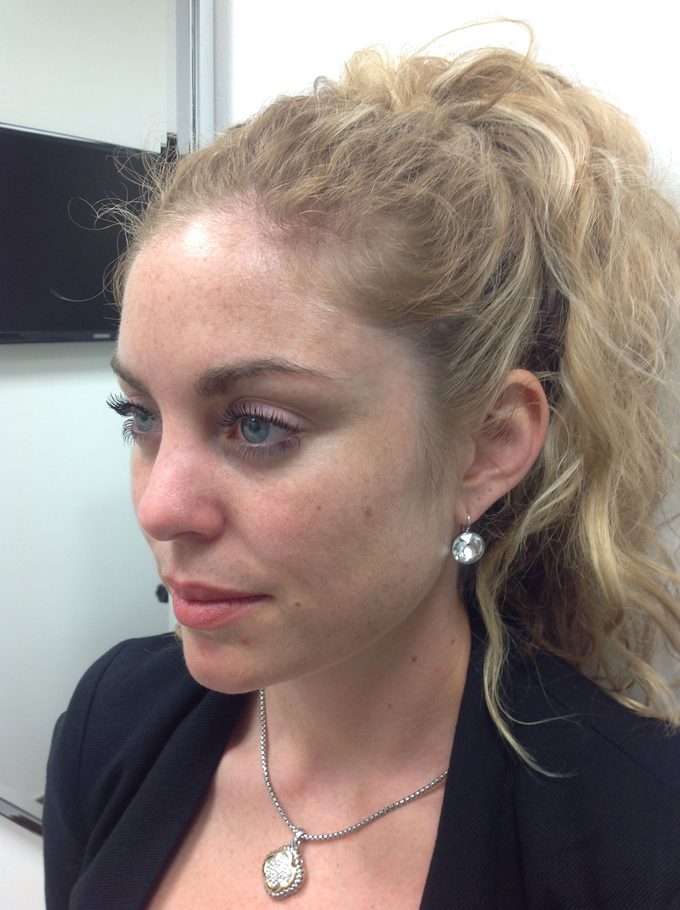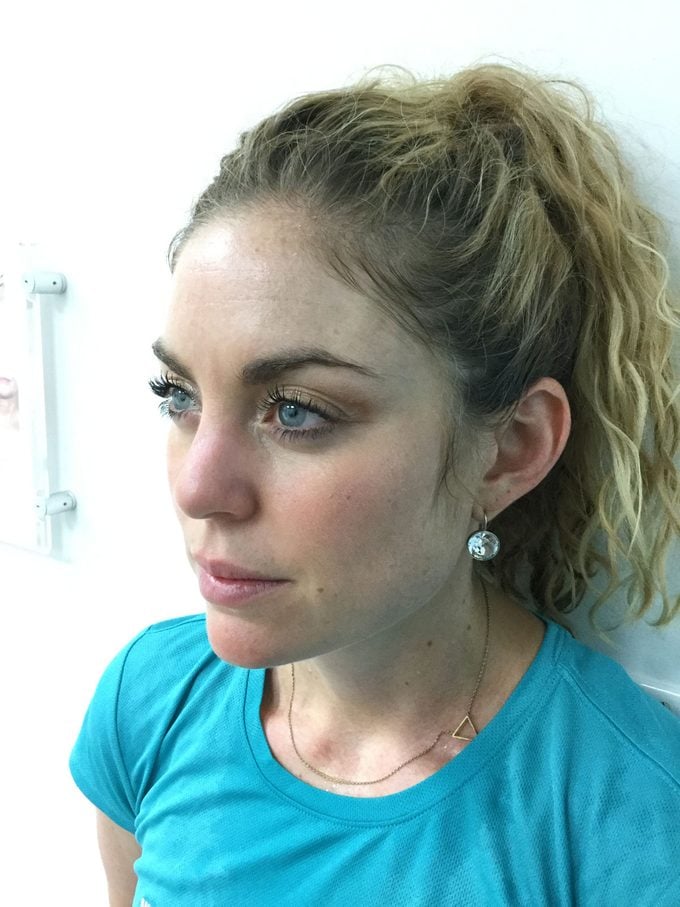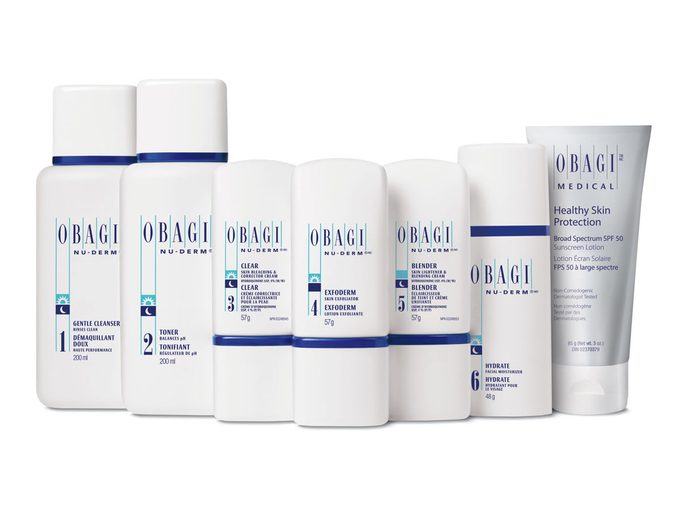How to Get Rid of Sun Damage for Good
A dermatologist-recommended medical skin care line gave this woman the opportunity for her skin to start fresh after years of not using enough SPF.
“I feel pretty good about my skin, but that might just be justification for the increasing amount of money that I’ve been spending on skin care products,” says Kelley Tessier. “I waited until the crows feet and wrinkles started before I really started to take care of skin.”
Tessier also lived in Australia for four years and admittedly never put enough sunscreen on. “I definitely enjoyed every minute of it, but now I’m really aware of the lasting effects it had on my skin.”
Already a patient of Dr. Julia Carroll’s at Compass Dermatology, Kelley decided it was time to do something about the fine lines, dullness, and freckles that were starting to become permanent on her nose, forehead and cheeks. After a consultation to evaluate Kelley’s skin type and what she was looking to achieve, Dr. Carroll prescribed the seven-step skin care system Obagi NuDerm.
“What we’re trying to do [with this system] is trigger a cascade: It minimizes the signs of premature aging, increases cell turnover through exfoliation, and improves the appearance of hyperpigmentation by inhibiting the production of melanin, which is the key to pigment in our bodies,” says Dr. Carroll. “The key ingredient [in the Obagi NuDerm system] is hydroquinone, a lightening agent that targets the melanocyte, inhibiting an enzyme called tyrosinase.” This potent ingredient diminishes freckles, age spots, post-inflammatory hyperpigmentation and even melasma. Your dermatologist decides what amount of hydroquinone and tretinoin to prescribe based on skin type and amount of sensitivity.
During the day, the process involves a gentle cleanser, toner, a “Clear” treatment (the hydroquinone-containing product), as well as an exfoliator called Exoderm (contains lactic, phytic, and glycolic acids), a moisturizer, and a sunscreen (SPF 50).
At night the only difference in the steps involves a foaming cleanser, as well as the addition of a “Blender” product, which is where tretinoin is introduced.
“Side effects are minor and expected, says Dr. Carroll. “You get a little red, your skin will peel and feel irritated, but that’s also how we know it’s working.” Eventually, a more even skin-tone appears as the melanin in pigment-making cells becomes more evenly distributed.
KelIey was prescribed a moderate tretinoin cream and used the normal to dry kit. Kelley was prescribed the system for a period of three to four months.
Here’s a short snapshot of Kelley’s experience:

Week One
“It took a few days to establish a routine of applying seven creams twice a day. (I previously only used a light Clinique soap and toner, followed by an eye cream and facial moisturizer morning and night.) The creams need a few moments to dry in between application, so I got into the habit of starting this routine first before doing anything else in the morning. After the first week of using the creams, my skin looked the exact same, but it felt different. It felt tighter it was starting to dry out. I had the inclination to start constantly moisturizing it. At the very end of the week, the tightness started to become a bit irritating – I had to stop myself from scratching or rubbing my face. I could see that the dry flakes were going to start any time as part of the anticipated “exfoliating” that was going to take place over the first few weeks.”
Week Three
“For the first two weeks, my skin became very dry, mainly in the T-zone. It was a little itchy as well. Apparently I was the only one that noticed the dryness, because halfway through week two I received multiple compliments from colleagues and friends on how fresh my face looked and if I had gone tanning. Apparently the tretinoin can give a red tinge and with my skin tone it was interpreted as a tan. Applying the creams to my face feels amazing – so soft and smooth, and something that I have never experienced before. My skin has changed so much in only two weeks: the freckles are fading and my skin tone is evening out. I’ve even stopped wearing cover up because now I think I look better without it (things I never thought I would say!). I’m going to keep rolling with the au naturel look.”
Week Five
“My skin still looks bright and clean, and the redness has come down a bit, though it still continues to flake and peel in some areas sporadically. The most drastic improvements were seen/felt within the first few weeks. Now the changes are subtler and less noticeable to me. My skin feels pretty good – I don’t feel the dryness as much anymore and there’s no real tightness.”
Week Seven
“I am most surprised at just how much my skin has changed. I honestly didn’t think my sunspots were that horrible or making me look aged before we started the Obagi treatments. But now I can see just how bad they were. My skin feels younger, it looks younger, and bright. I feel like I got to hit the “restart” button on my skin. I am going to continue to wear a minimum of SPF 50 daily and protect my face always.”

Overall
“I would definitely recommend this product. I always thought my age was just starting to show on my face since I’m in my 30s. I never thought these signs of aging were from previous damage that contributed to the wrinkles and lines. I looked specifically to firming creams to correct, but with marginal results. This process taught me to focus on the areas I had directly damaged (too long in the sun without sunscreen) and by improving on sun protection, the other signs of aging started to naturally disappear. I look and feel so much younger and overall better about my skin. I will definitely be smarter about protecting and treating my skin moving forward.”
Related:
• What to Expect From a Full-Body Skin Exam
• The Best New Sunscreens for 2016
• 3 Topical Treatments Your Skin Needs





